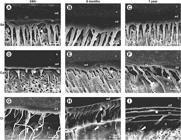Abstract
The aim of this study was to evaluate the μTBS in different dentin substrates and water-storage periods. Twenty-four dentin blocks obtained from sound third molars were randomly divided into 3 groups: Sound dentin (Sd), Caries-affected dentin (Ca) and Caries-infected dentin (Ci). Dentin blocks from Ca and Ci groups were subjected to artificial caries development (S. mutans biofilm). The softest carious tissue was removed using spherical drills under visual inspection with Caries Detector solution (Ca group). It was considered as Ci (softer and deeply red stained dentin) and Ca (harder and slightly red stained dentin). The Adper Single Bond 2 adhesive system was applied and Z350 composite blocks were built in all groups. Teeth were stored in deionized water for 24 h at 37 ºC and sectioned into beams (1.0 mm2 section area). The beams from each tooth were randomly divided into three storages periods: 24 h, 6 months or 1 year. Specimens were submitted to µTBS using EZ test machine at a crosshead speed of 1.0 mm/min. Failure mode was examined by SEM. Data from µTBS were submitted to split plot two-way ANOVA and Tukey’s HSD tests (a=0.05). The µTBS (MPa) of Sd (41.2) was significantly higher than Ca (32.4) and Ci (27.2), regardless of storage. Ca and Ci after 6 months and 1 year, presented similar µTBS. Mixed and adhesive failures predominated in all groups. The highest µTBS values (48.1±9.1) were found for Sd at 24 h storage. Storage of specimens decreased the µTBS values for all conditions.
Key Words:
dentin; artificial caries; S. mutans; storage time; microtensile bond strength.

 Thumbnail
Thumbnail
 Thumbnail
Thumbnail

